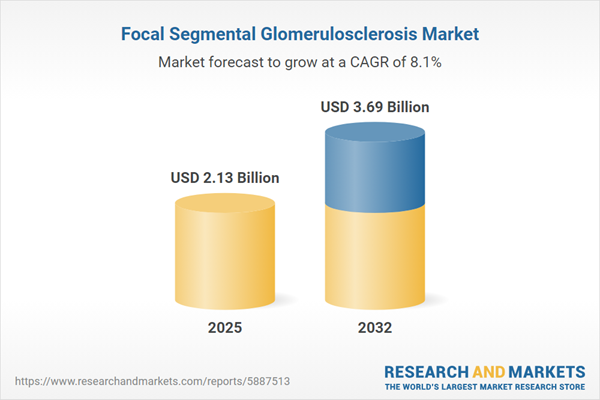Speak directly to the analyst to clarify any post sales queries you may have.
The focal segmental glomerulosclerosis market demonstrates robust expansion, reflecting evolving clinical strategies, increasing therapy innovation, and regional shifts in patient care models. Stakeholders navigating this sector must align their decision-making with advancements in biomarker validation, emerging geographic trends, and stakeholder collaboration.
Market Snapshot: Focal Segmental Glomerulosclerosis Market Growth and Trends
The focal segmental glomerulosclerosis market grew from USD 1.98 billion in 2024 to USD 2.13 billion in 2025. It is expected to continue growing at a CAGR of 8.07%, reaching USD 3.69 billion by 2032.
This substantial growth highlights greater demand for advanced, patient-centric therapeutic options. The sector is characterized by swift adoption of targeted therapies, increased investment in research, and the emergence of collaborative care models. Regional expansion is notable as healthcare infrastructure, reimbursement strategies, and regulatory innovations shape access to cutting-edge treatment worldwide.
Scope & Segmentation
The report delivers comprehensive coverage of the focal segmental glomerulosclerosis market, with analysis across technology, therapy, patient segments, and key geographies. Segmentation encompasses the therapeutic landscape, care settings, patient populations, and regional market variations.
- Drug Class: Angiotensin Enzyme Inhibitors, Angiotensin Receptor Blockers, Corticosteroids
- Stage: Primary, Secondary
- End-Use: Clinics, Hospitals
- Patient Type: Adults, Pediatric
- Geographic Regions: Americas (United States, Canada, Mexico, Brazil, Argentina, Chile, Colombia, Peru), Europe (United Kingdom, Germany, France, Russia, Italy, Spain, Netherlands, Sweden, Poland, Switzerland), Middle East (United Arab Emirates, Saudi Arabia, Qatar, Turkey, Israel), Africa (South Africa, Nigeria, Egypt, Kenya), Asia-Pacific (China, India, Japan, Australia, South Korea, Indonesia, Thailand, Malaysia, Singapore, Taiwan)
- Companies: Alkem Laboratories Ltd., Bristol Myers Squibb Company, Certa Therapeutics Pty Ltd., Cipla Ltd., CMG Biotech Pvt. Ltd., Dr Reddy's Laboratories Ltd., Fresenius Kabi Pvt. Ltd., GSK PLC, Hikma Pharmaceuticals PLC, Intas Pharmaceuticals Ltd., Lupin Ltd., Merck & Co., Inc., Novartis AG, Otsuka Pharmaceutical Co., Ltd, Pfizer, Inc., Sanofi S.A., Travere Therapeutics, Inc., Vera Therapeutics Inc.
Key Takeaways: Strategic Insights for Senior Decision-Makers
- The success of focal segmental glomerulosclerosis management depends on patient-centric approaches, including robust biomarker integration and precision medicine frameworks that inform therapy selection and clinical trial design.
- Collaborative partnerships between biopharmaceutical companies, academic institutions, and advocacy organizations enhance the development of innovative treatment modalities and real-world evidence generation, ensuring alignment with evolving clinical standards.
- Growing adoption of digital health solutions and remote monitoring tools supports continuous, personalized care, driving improved patient adherence and earlier intervention in care pathways.
- Differentiated regional strategies, particularly in Asia-Pacific and EMEA, are crucial due to diverse patient populations, infrastructure capacity, and regulatory nuances affecting therapy uptake and market entry.
- Corporate agility and portfolio diversification, including investment in new modalities such as molecular therapies and RNA-based treatments, are fueling competition and expanding access to advanced therapies.
Tariff Impact: Navigating Supply Chain and Cost Pressures
Recent changes in US trade tariffs have prompted supply chain recalibration, with raw material procurement, distribution networks, and logistics models being optimized to mitigate cost and access risks. Companies are exploring nearshoring, vertical integration, and enhanced collaboration with government agencies to maintain continuity in therapy availability and shield development priorities from volatility.
Methodology & Data Sources
This report uses a mixed-methods approach, integrating in-depth interviews with nephrology experts, payers, and patient advocates with structured surveys of commercial and clinical stakeholders. Secondary research draws on peer-reviewed journals, regulatory filings, and international conference proceedings. Findings are validated through thematic analysis, cross-comparison, and collaborative expert workshops to ensure rigor and reliability.
Why This Report Matters
- Informs executive strategy by contextualizing innovative treatment modalities, patient selection protocols, and supply chain resilience initiatives in a dynamic and globally evolving market.
- Supports investment decisions with actionable insights into region-specific regulatory trends and partnership models that drive sustainable growth and access.
- Equips stakeholders to navigate changing care models by aligning product portfolios and commercialization tactics with evolving patient needs.
Conclusion
The focal segmental glomerulosclerosis market is shaped by precision innovation, agile supply chains, and cross-sector collaboration. Decision-makers leveraging these insights will be well positioned to guide their organizations in this dynamic therapeutic field.
Additional Product Information:
- Purchase of this report includes 1 year online access with quarterly updates.
- This report can be updated on request. Please contact our Customer Experience team using the Ask a Question widget on our website.
Table of Contents
3. Executive Summary
4. Market Overview
7. Cumulative Impact of Artificial Intelligence 2025
Companies Mentioned
The companies profiled in this Focal Segmental Glomerulosclerosis market report include:- Alkem Laboratories Ltd.
- Bristol Myers Squibb Company
- Certa Therapeutics Pty Ltd.
- Cipla Ltd.
- CMG Biotech Pvt. Ltd.
- Dr Reddy's Laboratories Ltd.
- Fresenius Kabi Pvt. Ltd.
- GSK PLC
- Hikma Pharmaceuticals PLC
- Intas Pharmaceuticals Ltd.
- Lupin Ltd.
- Merck & Co., Inc.
- Novartis AG
- Otsuka Pharmaceutical Co., Ltd
- Pfizer, Inc.
- Sanofi S.A.
- Travere Therapeutics, Inc.
- Vera Therapeutics Inc.
Table Information
| Report Attribute | Details |
|---|---|
| No. of Pages | 190 |
| Published | November 2025 |
| Forecast Period | 2025 - 2032 |
| Estimated Market Value ( USD | $ 2.13 Billion |
| Forecasted Market Value ( USD | $ 3.69 Billion |
| Compound Annual Growth Rate | 8.0% |
| Regions Covered | Global |
| No. of Companies Mentioned | 19 |









